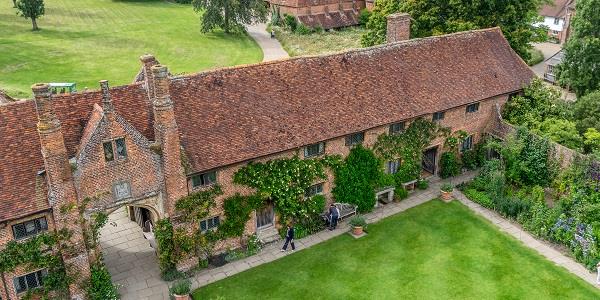
The southern counties of England are characterised by castles – fortifications, built primarily to repel invaders from across the channel. And, barring one incursion in 1066, across the centuries they seem to have done a pretty good job.
But over the years, the purpose of the castles has changed. As fears of invasion receded (at least, the kind of invasions that might be fought off from ancient citadels) these bastions grew prettier, slowly but surely changing from fearsome fortresses into gorgeous country houses and stately homes. In most cases, evidence of a warlike past remains; but no longer match-fit, England’s southern castles became manor houses for the wealthy and titled. Naturally enough, the landed gentry wanted as much opulence outdoors as in; and so developed the beautiful gardens that now surround these once-fearsome edifices.
Appropriately enough, this is particularly true in Kent – the ‘Garden of England’ – where holidaymakers at Sibton Park have an enormous range of gardens to visit, and enjoy. The gardens of the Garden of England are too numerous to catalogue here. So these are our top five:
Chiddingstone

Set in 35 acres of informal gardens with breathtaking views of the North Downs, large lawns for picnics, an intimate rose garden, woodland and a beautiful fishing lake, Chiddingstone Castle’s springtime daffodil display on the East Meadow is truly spectacular. But since 2014 there’s a been a year-round treat: ‘The Fields of Eternity’. This innovative garden is intended as a microcosm of Ancient Egypt, where visitors can learn about life and the environment 4,000 years ago by exploring carefully prepared paths of grasses, wild flowers and crops laid out to represent the River Nile, with tributaries leading to ‘tombs’ and other exciting discoveries.
Chiddingstone is open until 31st October 2018 on Monday, Tuesday, Wednesday and Sunday. Entry costs £9.50 per adult, £4.50 per child aged five to 13. Under fives are free. Further information can be found by clicking here.
Chilham

Chilham Castle is a private home, lived in by the Wheeler family – very picturesque, with fanastic views. You’ll be bowled over by the sheer elegance, grace and spectacle of the gardens, with truly classic terraces leading down through interestingly planted areas to a tranquil and delightful lakeside walk. You’ll get a glimpse of the way of life enjoyed by our more prosperous forebears (and, presumably, the Wheelers today!). The gardens form part of a larger parkland estate that wends its way across many acres, almost to The Kings Wood: a large forestry attraction. Worth a long wander, if you get the chance.
The gardens are open to the public on selected days throughout the year, most often on a Tuesday. Entry costs £5 per adult, £4 for concessions. Under fives are free. Further information can be found by clicking here.
Hever

Famously the childhood home of Anne Boleyn, Henry VIII’s unfortunate second wife, Hever Castle has a less militaristic past than some: more country mansion than fortress (though it has its share of battlements and arrow-slits). The gardens are more recent, having largely been created during the early 20th Century after American millionaire Henry Waldorf Aster bought the place to use as a family home. Visitors can get lost in the yew maze, planted in 1904.; can risk a soaking in the water maze, opened in 1999, the object of which is to get to the folly at the centre without getting wet; and marvel at the Italianate garden (including Fernery), rose gardens, herb garden, and superb examples of topiary that grace Hever’s 125 acres.
Hever Castle’s gardens are open throughout the year, though opening hours are restricted during the winter.
Gardens-only entry costs £14.50 per adult, £9.20 per child aged five to 15. Under fives are free, and there are various other concessions. Further information can be found by clicking here.
Sissinghurst

Though its history stretches back to Elizabethan times, Sissinghurst – modern-day Sissinghurst, at any rate – is all about one person: Vita Sackville-West, who, with husband Harold Nicolson bought the then-rundown Kentish mansion (sometime pig farm, prisoner-of-war camp and poor house) and set about renovating the place.
Though not the garden – there was no garden to renovate. Instead, Vita created a garden – in reality a series of gardens – which have become world-famous. Both Vita and Harold were adherents to the Arts and Crafts movement, and self-styled ‘artist-gardener’ Vita took responsibility for the planting, following the guidelines of horticultural supremo Gertrude Jeckyll and using colour themes in her designs. The results are sublime.
Sissinghurst (house and gardens) are open daily until 31st October 2018.
Entry costs £13.15 per adult, £6.75 per child. Further information can be found by clicking here.
Walmer

A redoubt built by Henry VIII to repel possible invasion from France and the Holy Roman Empire, Walmer Castle, ‘home’ to the Lord Warden of the Cinque Ports, is historically significant but not especially pleasing to the eye – in fact, the gardens were created in an effort to combat this, to soften the features of a very utilitarian fortress. Work on the garden began in the late 1700s, and it has grown organically ever since; the latest addition is the Queen Mother’s Garden, designed in 1997 by Penelope Hobhouse to commemorate the then-presiding Lord Warden’s 95th birthday. Highlights include the kitchen garden, in particular the glasshouse range, and the enormous double herbaceous borders flanking the Broadwalk, recently replanted in the style of Gertrude Jekyll, with an enormous hedge that protects them from the elements.
Walmer Castle and gardens are open throughout the year, except for when the Lord Warden is in residence. Hours are restricted during the winter months.
Entry costs £10.90 per adult, £6.50 per child aged five to 17. There are various other concessions. Further information can be found by clicking here.

